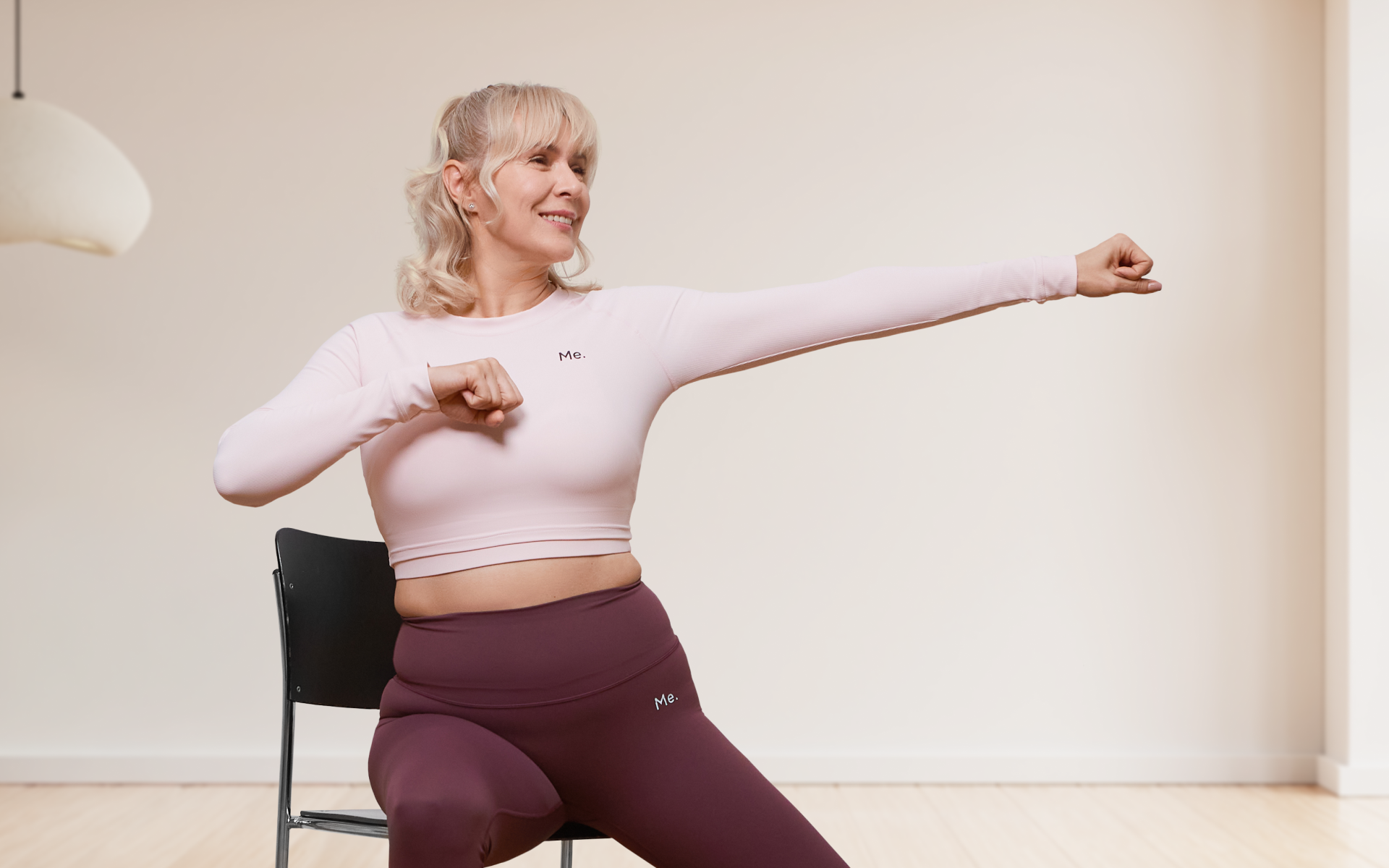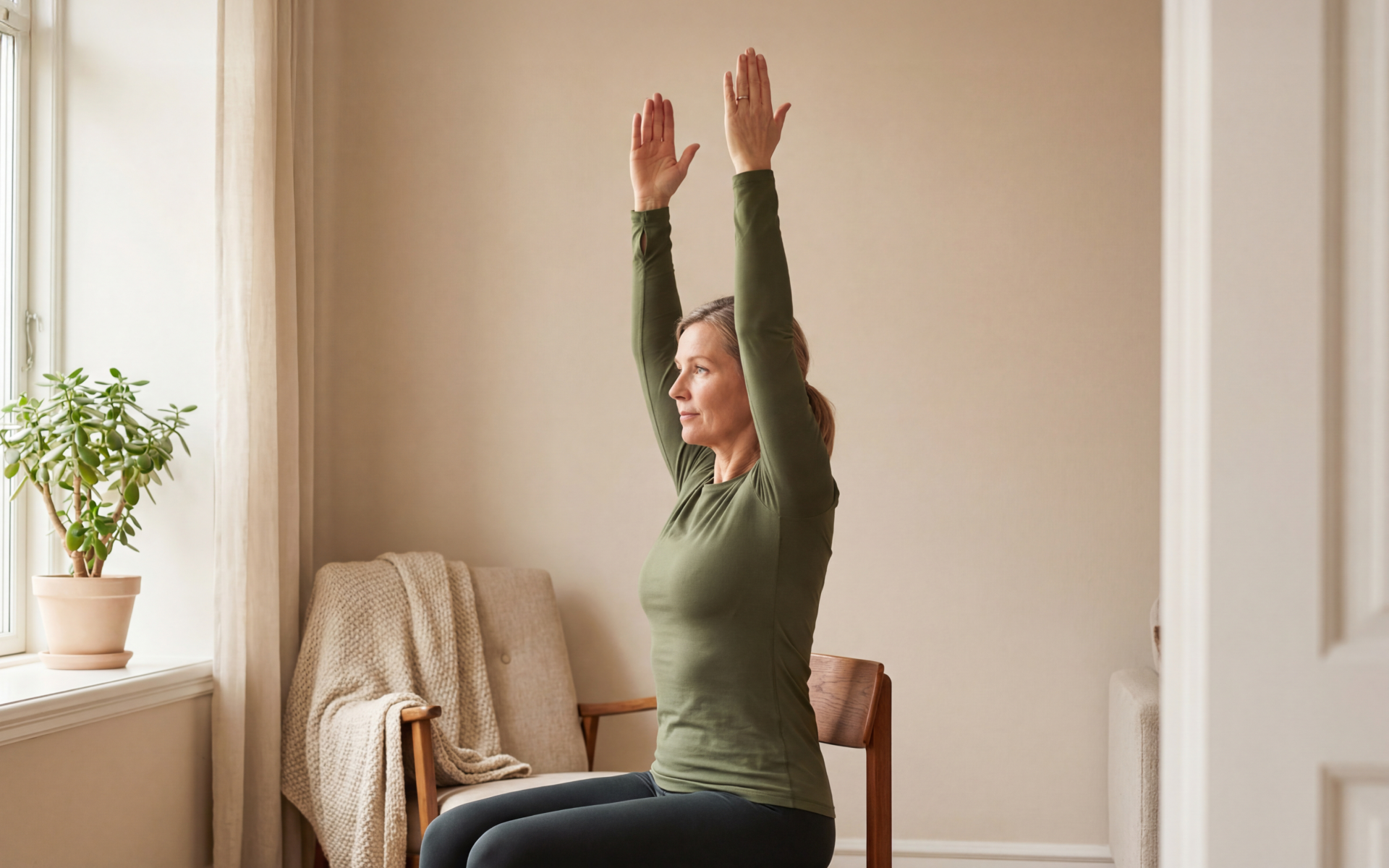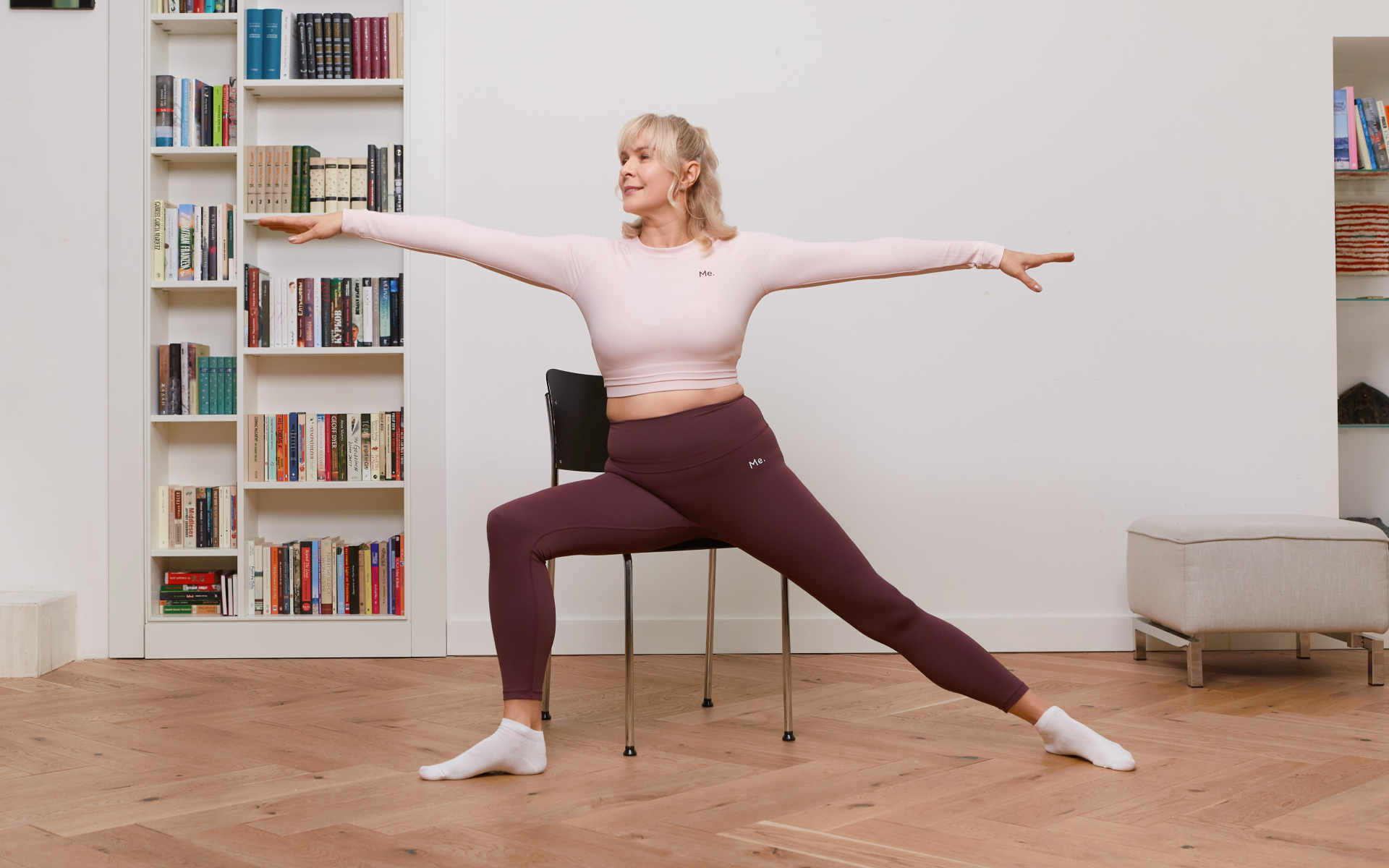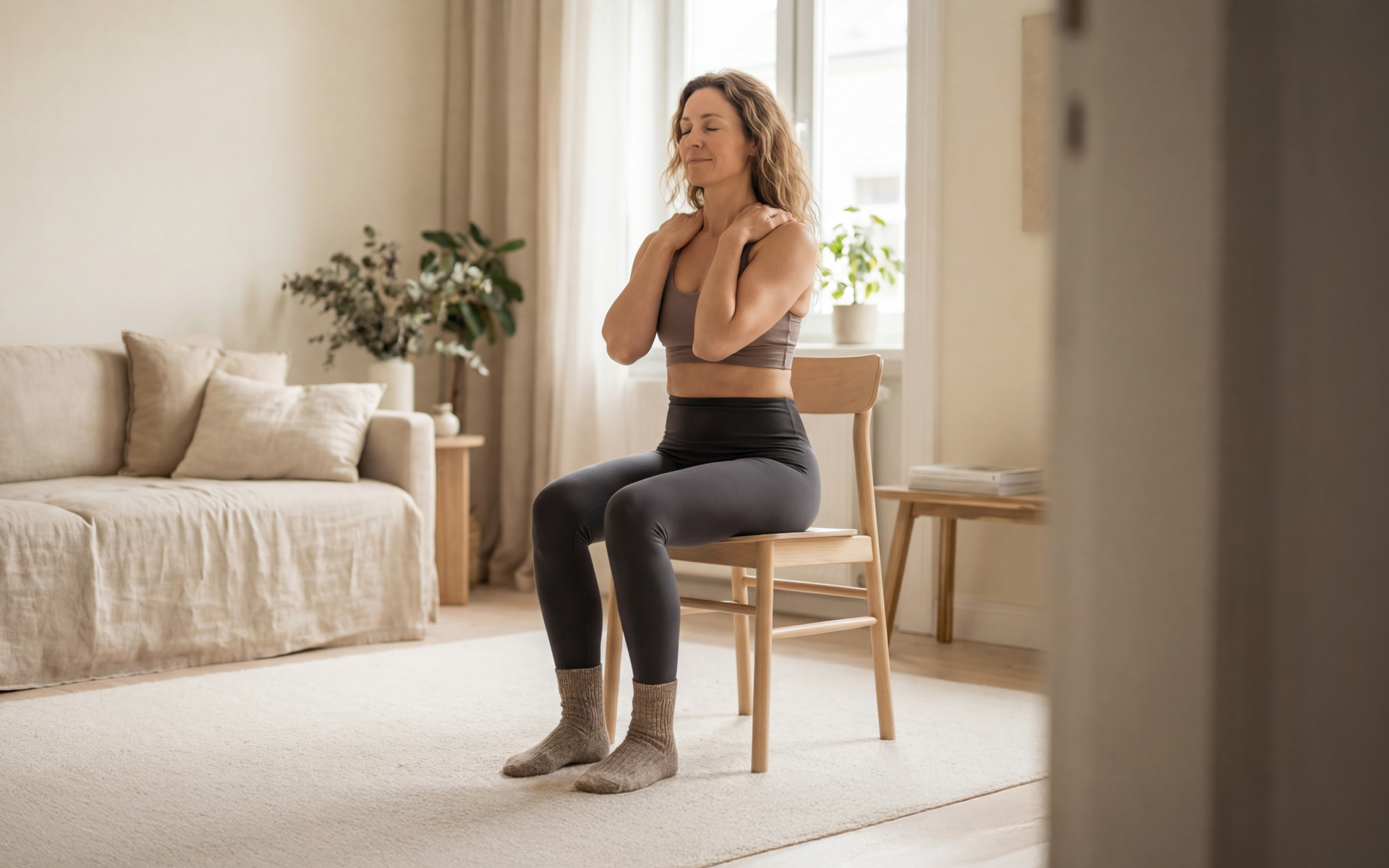Core strength is one of the most important aspects of physical fitness, especially for seniors. A strong core can improve balance, stability, and posture, and reduce the risk of falls and injuries (1). Many people may think that core exercises require a lot of equipment or gym membership, but there are actually many effective chair exercises that can help seniors build their core strength, all from the comfort of their home.
These chair exercises are typically safe enough for seniors to do at home, and can be modified for different fitness levels. We recommend working with a fitness professional or doctor to determine which exercises are appropriate for your body and current fitness level. The best exercise is one that you can do consistently and with proper form. Utilizing a certified fitness professional and a doctor would be your best bet to make sure you can complete these exercises in a safe manner.
What Are Core Chair Exercises?
Core chair exercises are low-impact movements that focus on strengthening the muscles in your abdomen, back, and pelvis. They are designed to be done while seated on a stable chair, making them typically accessible for seniors with mobility limitations and those who may not feel comfortable performing exercises on the floor.
In our previous blog, Chair Exercises for Seniors we compiled a list of effective low impact workouts for seniors.
Are Chair Ab Workouts Effective?
Chair core workouts can engage all of the major muscle groups in your abdomen, including your rectus abdominis, obliques, and transverse abdominis. These muscles work together to support your spine and improve stability. When done correctly and consistently, chair ab workouts can be just as effective as traditional floor exercises.
How Do You Strengthen Your Core In a Chair?
You strengthen your core in a chair using movements that engage your core muscles, such as twisting, rotating, or lifting your legs. These exercises may also include using light weights or resistance bands to increase the intensity of the workout.
Seniors should make the following considerations when performing chair core exercises:
- Start with exercises that are easy and comfortable for you, and gradually increase the difficulty as you get stronger.
- Focus on proper form and alignment to avoid injury (2). It’s better to do fewer reps with good form than to rush through many reps with poor form.
- Remember to breathe throughout each exercise, inhaling deeply and exhaling fully.
- If you feel any pain or discomfort, stop the exercise and consult with a fitness professional or doctor.
- Always warm up before starting your workout and cool down afterwards to prevent muscle strain and injury (3).
The BetterMe: Health Coaching app will provide you with a host of fat-frying fitness routines that’ll scare the extra pounds away and turn your body into a masterpiece! Get your life moving in the right direction with BetterMe!
What Core Exercises Can You Do Sitting?
Most floor and standing core exercises can be modified to be done in a seated position. Here are seven examples of effective chair exercises for seniors:
- Knee-to-Chest
- Extended Leg Raises
- Leg Kicks
- Modified Planks
- Tummy Twists
- Seated Bicycle
- Side Reaches and Twists
Knee-to-Chest
The Knee-to-Chest exercise primarily targets the lower abdominal muscles and hip flexors. These muscles are essential for maintaining stability and proper posture, as well as for performing everyday activities like standing up and walking. Strengthening these muscles can reduce the risk of falls and improve overall mobility.
Steps to Execute:
- Sit up straight in a sturdy chair with your feet flat on the floor and your knees bent at a 90-degree angle.
- Place your hands on the sides of the chair or grip the seat for additional support.
- Slowly lift your right knee toward your chest as high as is comfortable, keeping your back straight and your abdominal muscles engaged.
- Hold the knee-to-chest position for a moment, then slowly lower your right leg back to the starting position.
- Repeat the motion with your left leg.
- Continue alternating legs for a total of 10-15 repetitions on each side.
Modifications:
- If you find it difficult to lift your knee high, start with smaller movements and gradually increase your range of motion as your strength improves.
- For added difficulty, lift both knees at the same time, but be sure you maintain proper form and balance.
Precautions:
- Avoid arching your back or leaning backward while lifting your knees.
- Discontinue the exercise if you experience any pain or discomfort, and consult with a fitness professional or doctor for advice.
Extended Leg Raises
Extended Leg Raises are excellent for engaging the lower abdominal muscles, quadriceps, and hip flexors. These exercises are beneficial for improving leg strength and stability, which are crucial for maintaining balance and preventing falls.
Steps to Execute:
- Sit up straight in a sturdy chair with your feet flat on the floor and your knees bent at a 90-degree angle.
- Place your hands on the sides of the chair or grip the seat for additional support.
- Extend your right leg out in front of you, keeping it straight and about parallel to the ground, while keeping your abdominal muscles engaged.
- Hold the extended position for a moment, then slowly lower your leg back to the starting position.
- Repeat the motion with your left leg.
- Continue alternating legs for a total of 10-15 repetitions on each side.
Modifications:
- If you find it difficult to keep your leg fully extended, try performing the exercise with your knee slightly bent.
- To increase difficulty, add ankle weights for extra resistance.
Precautions:
- Make sure that your back remains straight and do not lean backward while lifting your leg.
- Stop the exercise if you feel any pain or discomfort, and consult a fitness professional or doctor for guidance.
Read more: Transform Your Workspace With 10 Chair Exercises for Lower Back Pain
Leg Kicks
Leg Kicks are designed to target the lower abdominal muscles, hip flexors, and quadriceps. These muscle groups play a vital role in maintaining core stability, supporting the lower back, and improving overall mobility. Strengthening these areas can help seniors enhance their balance, reduce the risk of falls, and perform daily activities with greater ease.
Steps to Execute:
- Sit up straight in a sturdy chair with your feet flat on the floor and your knees bent at a 90-degree angle.
- Place your hands on the sides of the chair or grip the seat for additional support.
- Extend your right leg out in front of you until it is straight and parallel to the ground, keeping your abdominal muscles engaged.
- Slowly lower your right leg back to the starting position.
- Repeat the motion with your left leg.
- Continue alternating legs with a fluid motion, performing 10-15 repetitions on each side.
Modifications:
- If extending your leg fully is difficult, try performing the exercise with a slight bend in your knee.
- To increase the difficulty, add ankle weights for additional resistance.
Precautions:
- Make sure to keep your back straight and avoid leaning backward.
- Discontinue the exercise if you experience any pain or discomfort and consult with a fitness professional or doctor.
Modified Planks
Modified Planks utilize the chair for support and primarily engage the core, including the rectus abdominis, obliques, and transverse abdominis. Additionally, they activate the upper body muscles like the shoulders, chest, and arms.
Strengthening these muscle groups improves posture, enhances core stability, and supports overall body strength, which is especially beneficial for seniors.
Steps to Execute:
- Place a sturdy chair against a wall to ensure it doesn’t move.
- Stand behind the chair and place your hands on the seat or the backrest, depending on what feels more secure.
- Walk your feet backward until your body forms a straight line from your head to your heels, maintaining a plank position with your weight supported by your hands and toes.
- Keep your abdominal muscles engaged, your back straight, and your shoulders aligned over your wrists.
- Hold the plank position for 10-20 seconds, then slowly walk your feet forward to return to a standing position.
- Repeat this process for a total of 3-5 repetitions.
Modifications:
- If holding the plank for the suggested duration is challenging, start with shorter intervals and gradually increase the hold time as you build strength.
- For added support, perform the plank with your forearms on the seat of the chair instead of your hands.
Precautions:
- Make sure that the chair is stable and will not move during the exercise.
- Avoid letting your hips sag or raising them too high; aim for a straight line from head to heels.
- Stop the exercise if you experience any pain or discomfort, and consult a fitness professional or doctor for further advice.
Tummy Twists
Tummy Twists focus on the abdominal muscles, particularly the obliques, which are essential for maintaining core stability and improving rotational strength. Strengthening these muscles enhances the ability to perform daily activities such as twisting to reach for objects, improving overall balance, and reducing the risk of falls.
Steps to Execute:
- Sit up straight in a sturdy chair with your feet flat on the floor and knees bent at a 90-degree angle.
- Place your hands on your chest or hold a lightweight object for added resistance.
- Engage your abdominal muscles and slowly twist your upper body to the right, keeping your hips and legs stationary.
- Hold the twist for a moment, then slowly return to the starting position.
- Repeat the motion to the left side.
- Continue alternating sides for a total of 10-15 repetitions on each side.
Modifications:
- If twisting fully is difficult, perform the exercise with smaller twists and gradually increase your range of motion.
- To increase the difficulty, hold a light weight or resistance band while performing the twists. But be sure that you have the correct form down before trying to add external weight to this exercise. More weight can increase your likelihood of injuring your lower back.
Precautions:
- Keep your back straight and do not lean forward or backward while twisting.
- Discontinue the exercise if you experience any pain or discomfort, and consult with a fitness professional or doctor for advice.
BetterMe is your fast-track ticket to long-lasting weight loss! Tailor your fitness journey and maximize your results with just a couple of swipes!
Seated Bicycle
The Seated Bicycle exercise targets the lower abdominal muscles, obliques, and hip flexors. Strengthening these muscle groups is beneficial for improving core stability, enhancing lower body strength, and supporting a greater range of motion in everyday activities.
Steps to Execute:
- Sit up straight in a sturdy chair with your feet flat on the floor and knees bent at a 90-degree angle.
- Place your hands on the sides of the chair or grip the seat for additional support.
- Lift your right knee towards your chest while simultaneously twisting your upper body to bring your left elbow towards the raised knee.
- Return to the starting position and repeat the motion with your left knee and right elbow.
- Continue alternating sides in a fluid, cycling motion for a total of 10-15 repetitions on each side.
Modifications:
- If lifting your leg high is challenging, start with smaller movements and gradually increase the range of motion.
- For added difficulty, perform the exercise with both feet off the ground, mimicking a full bicycle pedaling motion.
Precautions:
- Avoid arching your back or leaning backward during the exercise.
- Stop the exercise if you experience any pain or discomfort, and consult a fitness professional or doctor for guidance.
Side Reaches and Twists
Side Reaches and Twists engage the oblique muscles and improve flexibility in the lateral and rotational movements of the torso. These exercises are useful for enhancing the ability to reach and twist comfortably, which is essential for many daily activities.
Steps to Execute:
- Sit up straight in a sturdy chair with your feet flat on the floor and knees bent at a 90-degree angle.
- Extend your right arm overhead and reach towards the left side, allowing your torso to gently bend to the left.
- Hold the stretch for a moment, then return to the starting position.
- Next, twist your upper body to the left, keeping your hands on your knees or the sides of the chair for support.
- Hold the twist for a moment, then return to the starting position.
- Repeat the side reach and twist on the opposite side.
- Continue alternating sides for a total of 10-15 repetitions on each side.
Modifications:
- If reaching overhead is difficult, perform the exercise with your hand resting on your shoulder.
- To increase the difficulty, hold a light weight or resistance band while performing the reaches and twists. Similar to the other twisting exercise mentioned in this article, please use caution when adding external weights.
Precautions:
- Make sure to keep your back straight and do not force the twist or reach beyond your comfortable range of motion.
- Discontinue the exercise if you experience any pain or discomfort, and consult a fitness professional or doctor for advice.
Find more exercise variations in our Chair Yoga Core Exercises blog.
How Can I Flatten My Stomach Sitting In a Chair?
Increasing the intensity of your chair workout to burn more calories is the key to flattening your stomach while sitting in a chair. Incorporating high-intensity interval training (HIIT) into your routine can lead to significant calorie burn and fat loss (4). Overall body fat loss will lead to stomach fat loss. .
Here are some tips to help you increase the intensity of your chair workout:
- Add resistance: Use light hand weights or resistance bands during exercises such as arm circles, side reaches, and seated bicycles.
- Increase speed: Perform each exercise at a faster pace, increasing your heart rate and burning more calories.
- Add intervals: Alternate between periods of high-intensity exercise and short rest periods for an effective HIIT session.
- Engage your core: Focus on keeping your abdominal muscles engaged and tight throughout the exercises to target those muscles specifically.
- Incorporate cardio: Add in some seated jumping jacks, chair step-ups, or chair squats to elevate your heart rate and burn more calories (5).
Note that spot reduction of fat is not possible, so while these exercises can help strengthen and tone your abdominal muscles, it’s essential to combine them with a balanced diet and overall fitness routine for optimal results.
Read more: How To Slim Down Quickly Using Chair Exercises for Weight Loss
FAQs
What Is The Single Best Core Exercise?
There’s no one “best” core exercise as different exercises target specific abdominal muscles and have varying levels of difficulty. It’s best to incorporate a variety of exercises into your routine, including planks, crunches, Russian twists, and seated bicycle twists.
Is It Ok To Do Ab Work Everyday?
It’s not recommended to do abdominal exercises every day, as your muscles need time to rest and recover. Aim for 2-3 days of core exercises per week, allowing for at least one day of rest in between sessions.
It’s beneficial to incorporate other types of exercises, such as cardio and strength training, into your daily routine. These activities also engage your core muscles and contribute to overall fitness and strength (6). When done with correct form, strength training will constantly engage your core so even if you are not directly working your core, it will still be used when lifting.
Do Ab Workouts Flatten Your Stomach?
Ab workouts can help tone and strengthen your abdominal muscles, but they won’t necessarily flatten your stomach on their own. Spot reduction of fat is not possible, so it’s essential to combine ab exercises with a healthy diet and overall fitness routine for optimal results.
Strengthening your core can improve posture and muscle activation in everyday activities (1), giving the appearance of a flatter stomach even if there hasn’t been a significant decrease in belly fat.
Can I Strengthen My Core After 70?
Yes, it’s never too late to start incorporating core exercises into your routine. However, it’s essential to consult with a doctor or fitness professional before beginning any new exercise program, especially if you have mobility issues or preexisting medical conditions.
Some modifications that may be necessary for older adults include using lighter weights and reducing the range of motion in certain exercises to avoid strain and injury. While exercising, focus on finding balance and stability rather than pushing for high-intensity movements. Always listen to your body and make adjustments as needed.
Find low impact yoga for seniors in our, Armchair Yoga article
The Bottom Line
Strengthening your core muscles through chair exercises is not only beneficial for physical appearance but also for overall health and functionality. Incorporating these exercises into your daily routine can improve posture, balance, flexibility, and even reduce back pain. It’s best to start slow, make modifications when necessary, and stop if you experience any pain or discomfort.
DISCLAIMER:
This article is intended for general informational purposes only and does not serve to address individual circumstances. It is not a substitute for professional advice or help and should not be relied on for making any kind of decision-making. Any action taken as a direct or indirect result of the information in this article is entirely at your own risk and is your sole responsibility.
BetterMe, its content staff, and its medical advisors accept no responsibility for inaccuracies, errors, misstatements, inconsistencies, or omissions and specifically disclaim any liability, loss or risk, personal, professional or otherwise, which may be incurred as a consequence, directly or indirectly, of the use and/or application of any content.
You should always seek the advice of your physician or other qualified health provider with any questions you may have regarding a medical condition or your specific situation. Never disregard professional medical advice or delay seeking it because of BetterMe content. If you suspect or think you may have a medical emergency, call your doctor.
SOURCES:
- The real-world benefits of strengthening your core (2012,harvard.edu)
- Warm Up, Cool Down (2024,heart.org)
- Prevent Injuries with Proper Form During Workouts (2021,nus.edu.sg)
- Effectiveness of high-intensity interval training for weight loss in adults with obesity: a randomised controlled non-inferiority trial (2021,nih.gov)
- Aerobic exercise alone results in clinically significant weight loss for men and women: Midwest Exercise Trial-2 (2013,ncbi.nlm.nih.gov)
- Cross Training (2020,orthoinfo.aaos.org)











